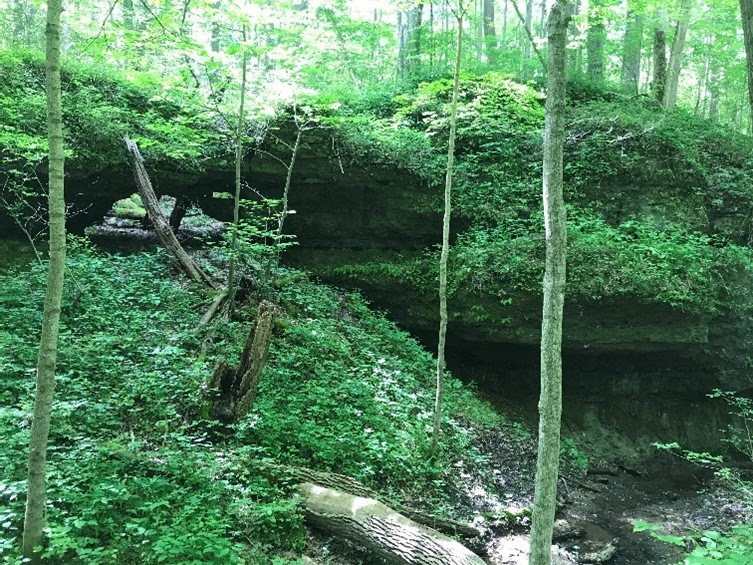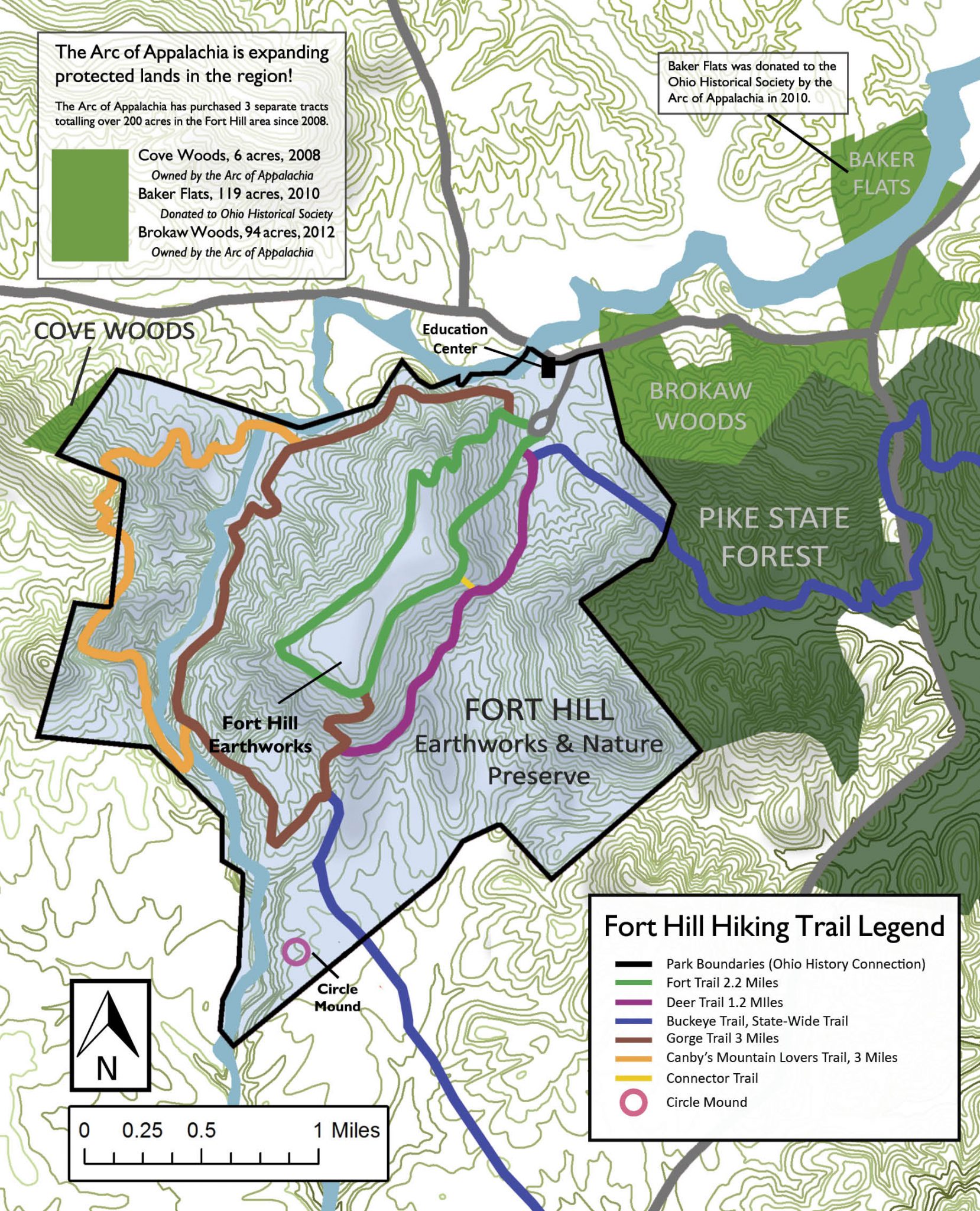Fort Hill Earthworks and Nature Preserve

Fort Hill Earthworks and Nature Preserve
13614 Fort Hill Road Hillsboro, Ohio 45133
Official WebsiteFort Hill (Arc of Appalachia) webpage
Fort Hill (Arc of Appalachia) map
Fort Hill (Buckeye Trail Association) hike
Also, see all the hotspots at:
Highland County Birding Drive
Tips for Birding
Fort Hill is owned by the Ohio Historical Society and managed by the Arc of Appalachia Preserve System. At the top of the hill is the fort for which the preserve is named, a stone and earthen-walled Hopewell hilltop enclosure with a circumference of 1.5 miles. Visitors can learn more about the history in the free museum that is open 12-5pm on Saturdays May – October. This remote hotspot is under-birded yet still has 118 recorded species on eBird generated from only 65 checklists. The entire preserve is 1600 acres, deemed one of the oldest and largest contiguous forests in all of Ohio and has 11 miles of trails that take hiking enthusiasts through upland forest, stream side forest, and a limestone gorge. The park entrance drive goes through prairie and overgrown field habitat. The best times of year to visit the area are April for wildflowers and migrating birds, May and June for breeding birds, and July and August for butterflies and dragonflies.
Located in southeastern Ohio, Fort Hill boasts an abundance of breeding birds that most birders in northern Ohio only experience during migration and then only seldomly when “overflight” occurs. In late May, the forest here echoes with the loud ringing songs of Kentucky and Hooded Warblers, seemingly each creek that enters the gorge hosts a pair of Louisiana Waterthrush, Wood Thrush and Acadian Flycatchers abound, and the soft, rapid trill of the Worm-eating Warbler and the rising song of the Cerulean Warbler and Northern Parula can occasionally be heard. Actually seeing these birds, most of which tend to be high in the foliage is a challenge, but persistence pays off for those that desire a feast for the eyes as well as the ears. Besides hiking in the gorge and forest, check the edge and more open habitats for Yellow-throated Warblers singing from the sycamores, strawberry-red Summer Tanagers calling “pitty-tuck”, the Yellow-breasted Chats that seem to be in every thicket in this part of the state, and listen for the Prairie Warbler’s buzzy, ascending song.
Fort Hill is located at 13614 Fort Hill Road, Hillsboro, OH (Highland County) in a remote, rural area where cell service can be spotty, so be prepared with off-line directions to and from the park. Sturdy hiking boots and even hiking poles are recommended to fully enjoy the trails, which are unimproved, rugged, and steep. Birders with limited physical ability still have the chance at most species from the parking lot or close to it. There is a picnic shelter and vault toilets near the parking lot. There are no parking or entrance fees to visit Fort Hill or the museum. Donations to the non-profit Arc of Appalachia Preserve System help keep Fort Hill open to the public without admission fees. Arc of Appalachia manages several other nearby preserves open to the public including Highlands Nature Sanctuary, Chalet Nivale, and Plum Run Prairie.
About this Location
Park and Hiking Trails: Open daily, dawn-dusk. Museum: Open Saturdays, May-October, 12-5pm. Free of Charge. There are no parking fees or entrance fees to visit Fort Hill or the Museum. Donations to the non-profit Arc of Appalachia Preserve System help keep Fort Hill open to the public without admission fees.
The major earthwork at Fort Hill is an ancient earthen-walled enclosure constructed on top of a large flat-topped ridge. The earthen-stone wall has a circumference over one and a half miles, its span interrupted with at 36 definite made-man openings, and three more possible constructed openings. The wall itself ranges from 6 to 15 feet in height, averages 30 feet wide at its base, and encloses 35.3 acres. It was built to follow the natural contour of the rim of the hill and is bordered on the inside wall by a substantial ditch. The total length of the embankment has been surveyed at 8,619 feet.
Fort Hill boasts a stunning natural area of 1300 acres, sheltering one of the largest and oldest contiguous forests in all of Ohio. It is estimated that the park preserves over 800 vascular species of plants within its boundaries, an outstanding remnant of the temperate deciduous forest that once covered nearly all of the eastern United States, and in earlier times, sheltered as many as 100,000 species of plants and animals. In 2015 Fort Hill was officially inducted as part of the Old Growth Forest Network.
Fort Hill is a nature preserve containing one of the best preserved prehistoric hilltop enclosure in North America. The Hopewell Indians (100 B.C.-A.D. 500) constructed the 1.5-mile long earthwork as well as at least two ceremonial buildings and probably a village in the Brush Creek Valley. Lying at the western edge of the Allegheny Plateau, immediately south of the glacial boundary, this hilly area contains an impressive diversity of bedrock, soils, flora, and fauna. There are 11 miles of hiking trails at the 1200-acre preserve, as well as a picnic area and latrines. The museum houses exhibits on the geology and archaeology of the area.
Fort Hill has what many call the best hiking trails in the state. Its fully mature forests harbor many rare or endangered wildflowers, hundreds of species of mushrooms a high number of tree species. Birders will likely be able to check off several hard-to-find species.
You can hike to a stone and earthen-wall Hopewell hilltop enclosure at the top of Fort Hill, with a circumference of 1.5 miles, with 33 gateways and a large ditch on the inside of the fort. A similar fort-style enclosure can be found at Fort Ancient, 50 miles away. Fort Hill’s hilltop earthworks are accessible only by hiking to the top, with two trails terminating at the enclosure.
For archaeology enthusiasts, the well-preserved hilltop enclosure at Fort Hill is spectacular. But Fort Hill also has second Hopewell earthwork. Circle Earthwork, in a field on the south side of the park, can be hard to see. A mowed trail leads to the earthwork and it is accessible from the Buckeye Trail.
Notable Trails
Fort Hill Trails
The trails through Fort Hill are a section of the Buckeye Trail. A total of eleven miles of hiking trails exist at Fort Hill, offering some of the best hiking in the entire state of Ohio. Because of the relatively long length of the preserve’s three trails, they are best suited for hiking enthusiasts. Hikers, please note backcountry trail conditions. It is wise to dedicate approximately one hour per mile in order to leisurely and safely enjoy Fort Hill’s backcountry trails. The trails are generally primitive in nature, being narrow, uneven, and traversing rolling hills that can sometimes approach steep. After rain or in the spring after winter snowmelt, the paths can be muddy, so please be prepared with proper footgear. Before coming in the fall/winter, be sure to check the dates the hiking trails are closed for the deer management hunt. Fort Hill is a protected natural area. Regulations require that hikers remain on the trails. Harvesting or disturbing plant and animal life are not permitted. Fishing is not permitted. Dogs are allowed but must be kept on a leash at all times.
For a short hike, take the 2.2-mile Fort Trail through the central area of the earthworks.
The trails through Fort Hill are a section of the Buckeye Trail. The Buckeye Trail Association website outlines a 6-mile hike using the Fort, Deer, and Gorge trails, with options to lengthen or shorten the hike.
Features
Restrooms on site
Wheelchair accessible trail
Entrance fee
Roadside viewing
Content from Official Website, Fort Hill (Arc of Appalachia) webpage, and Ohio Ornithological Society, Sarah Preston
Last updated February 11, 2023
